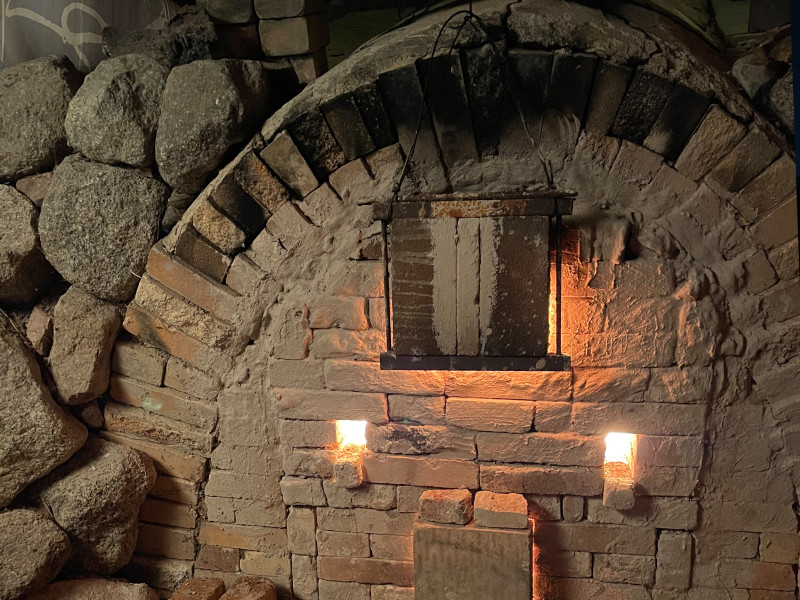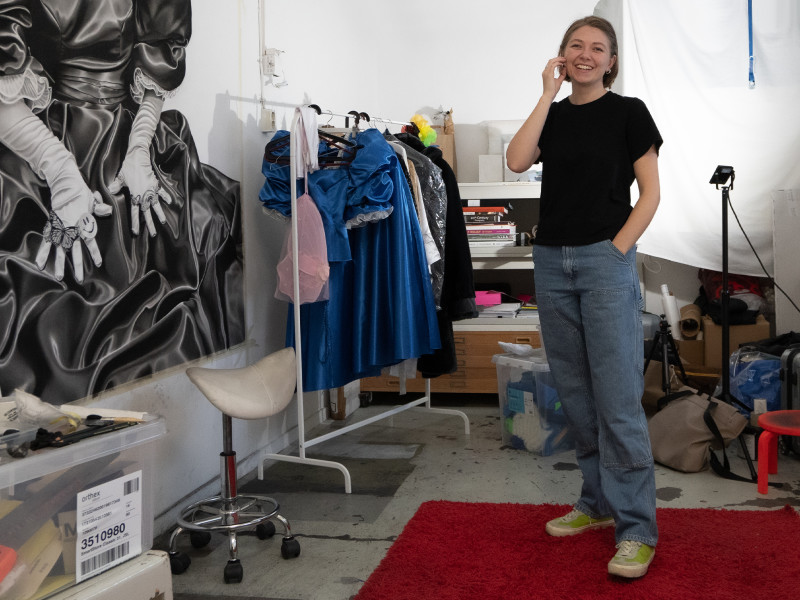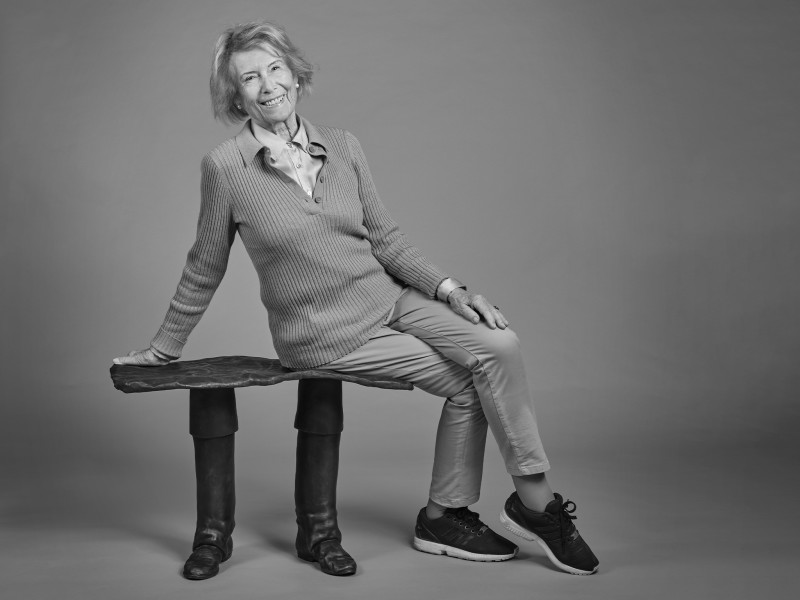In conversation with Ulf Rollof by Saskia Neuman
Interview
January 7, 2024
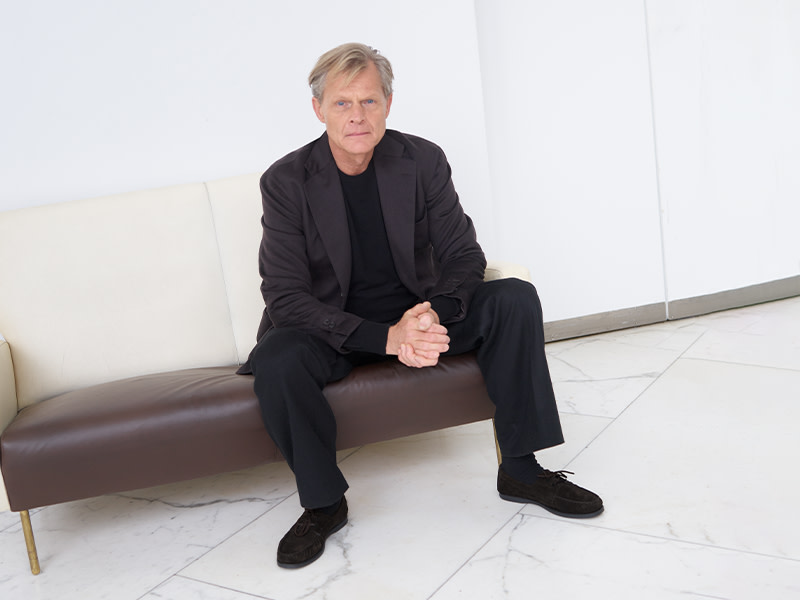
Ulf Rollof’s mild expression, a swift smile and intense stare is matched by the artist’s quick rapport throughout our conversation. Having lived for several years as a young man on America’s west coast, and later as a slightly more mature man in New York City, the Swedish artist not only expresses himself in English with ease but has taken custom to frothy Americanisms as his lingua franca… his enthusiasm is as infectious as his work. Beholden by routine due to his illness, Parkinson’s, we meet before lunch. ‘I am clear and coherent throughout the day’, he explains, ‘but I tire… meeting in the morning is preferable.’ The artist’s practice seems to have flourished, despite health challenges. ‘Time, or the lack of it, makes you more productive. I don’t have the luxury of being idle, I have a few hours each day to work, so I make them count, I must be effective. As you get older you become more efficient, you’re focused.’
Rollof is thrilled ahead of his fifth solo exhibition at CFHILL. In the exhibition, titled Pairs, he revisits his seminal Shoot Paintings, a series of work that he has come back to in instances over the years. The Shoot Paintings, along with monumental new Flower Paintings aim to weave the exhibition together. The combination of two distinct narratives within Rollof’s practice is intended to create nuances of familiarity, as well as anticipation of the introduction of completely new work. It is as if the artist’s intention is to create a well of knowledge within his own painterly practice, pairing the new series of works with reflection and his personal memory of his oeuvre.
So much has been written about Ulf Rollof, there is an almost perverse amount of information to be found about his life and practice. We take a more contemplative stroll down memory lane together. Revisiting the importance of influence, people and places that have made an impact on the artist, his life and practice.
Is memory important?
— I have very selective memory. Somethings I remember with great specificity, others are completely lost to me… things from my childhood I can’t recall at all. My youngest daughter Klara is like a tape recorder. She remembers everything we’ve ever done, every detail, which is a blessing, but can also be a bit of curse. How do we sort and differentiate good and bad memories…
I’ve been thinking about your works Skottmålningarna — the first ones you made were in 2003 (Shoot Paintings, the artist calls them RGB Paintings). Could you elaborate on these works?
— I’ve been making the RGB Paintings since 2003. The first ones were triptychs, red, green, and blue, relating to the color space of digital images which are built up out of RGB, when you work in photoshop… then they are shot. These paintings are physical, and fragile and they weigh at least 25 kg. They’re terrible to carry around, heavy as hell, and they’re problematic. The works are indescribable, because they’re not about shooting, they’re about pain. Referring to the situation I was in during 2003. No matter how I positioned my body I was in an immense amount of pain. How do you describe that? This was the only way I could do it.

Despite getting better, having treatment, you continued
making the paintings?
— Yes. Every year I make a new series… but this is the first time I have paired the paintings with another series of work.
How did this come about?
— After the pandemic ended, I was so happy to see all these flowers emerge from the ground, in the Spring. It was the first season after the pandemic ended where you could get out properly. I had been very isolated because of my sickness. My neurologist told me getting Corona wasn’t an option, I just couldn’t. I’ve never been scared in my life, never ever… this was the first time I experienced fear, for two years, and it was awful. Then, to come out, to see these flowers, was just a revelation.
How did you express this revelation?
— My last exhibition, about a year ago, was drawings, very colorful drawings of Narcissus flowers… in Swedish they’re called påskliljor. I didn’t even know that they were called Narcissus flowers. I mean it’s perfect. Now I am pairing these new paintings with the Shoot Paintings. They are identical in size and in mount, silicon mounted, behind glass… my hope is that the two objects match each other perfectly.
Do you still look at the Shoot Paintings as representations of your own pain, or can you view them through the lens of other people’s or types of discomfort?
— Yes, absolutely. Of course, the pain, or rather discomfort is more universal. They are relevant to everyone in different ways. That’s why they speak to people, and that’s why people collect them. For me, learning Sōtō Zen meditation really helped me survive. I spent time in Sausalito, in California. I guess this is what the work is about, overcoming obstacles, seeing elements in life from a new perspective.
How was it to spend time in California again, after having spent time there as a teenager, studying art?
— Total full circle. It all made sense. I came to San Diego as a 17-year-old, started making art, met my mentor, the artist Michael Schnorr.
California is important to you… during our conversation we’ve touched upon artists, including Niki de Saint Falle, and then more obvious influences such as the American artist Chris Burden…
— Yes, that’s an obvious influence. He was important to me when
I was young, he was a friend of a friend. Bruce Nauman is another very important reference of mine, his work has been a strong voice throughout my early practice. Film is another strong reference for me, I watch a lot of film, television. I am obsessed with film, and television.
Geography is another important component in your life, right?
— Yes, it is. Later, after California and Mexico I spent time in New York. I was there with Iaspis, a grant, but really longed for nature. When I was an exchange student in California, I had the great fortune of arriving in Imperial Beach, the most southern part of San Diego, where the border crossing to Mexico is located, it’s connected to Tijuana, joined by a swamp. It was a tough place, a military base, a navy town… like Karlskrona, where I grew up, but completely different. There were all these low riders there, motorcycle gangs… again, not dissimilar to where I grew up, they have Raggare (car/motorcycle aficionados) in Karlskrona. It was close to farmland; I grew up close to farmland. I had plans of becoming a Mexican citizen, I moved there in 1985, but then I had a family and life had other plans. So, I go back often, but to Mexico City, and spend a few months there at a time. For many years I wasn´t able to travel back to the remote mountain village San Bartolo Parreo where I lived 1985–1987. I learned Spanish in the village, and it was a very welcoming, fun and formative experience learning farming and customs in an ancient tradition. I was luckily able to travel there just before the pandemic to meet my old mentor Dona Maria Velez. Unfortunately, the village is only an hour away from Uruapan which is the center of the drug war today. So, I stay in Mexico City, with my service dog, she’s wonderful, and from Mexico. I keep a routine there, spend time in the sun, think, work… people are very open and polite. There is a mix of everything there, it’s the most cosmopolitan place.’
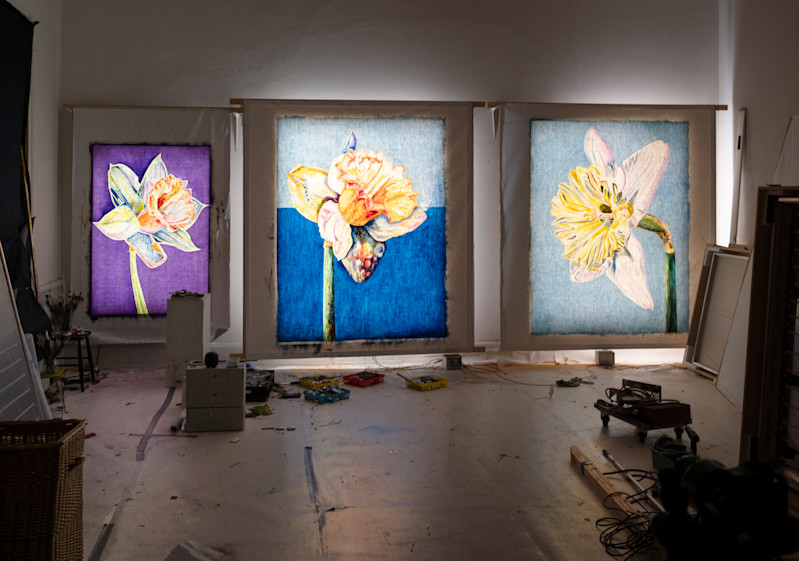
Back to memory… what other influences growing up made an impact on you? What experiences do you go back to, in your memory.
— I used to assist a friend of my mother, who was also an artist, Harald Kraft. He was very influenced by American pop art, I used to assist him as a kid. I am sure that made a huge impact. Another strong memory of an important influence came to me when I was working on my retrospective with Iris Müller Westermann at the Modern Museum of Art, in Malmö. When I was five my mother put me to work with a cobbler — Uncle Henry. I didn’t get along with the kids in preschool, kindergarten, so two years before I enrolled in school was spent with Henry, repairing shoes. That’s why I work with the material rubber. This memory, or rather this influence dawned on me when I was preparing my exhibition in Malmö. Henry had the shop next to where we lived in Karlskrona, he was a Jewish immigrant from Germany, he was a total hero. Another exhibition I did that is very important to me is Eve, Mom, Dad, The Machine and I, in 2001. It’s the first exhibition I made about my family. I love photography ever since I used to work as a black and white photo printer. I had been participating in a great deal of therapy with my therapist Ulla Wiggen (the artist), she’s very important to me. The combination of the machinery and sculpture that was in the exhibition, along with the yellow breast bowl made in Madame Tussaud casting wax, depicting the female form, with the photographs… it was an important show. I had been in such a bad place; the therapy was hard and intense. The course of therapy was very conversational, and at that time Ulla wasn’t making art, just engaging in therapy. Sometimes in life you really need support, Ulla was incredibly supportive. The photographs in the exhibition were amazing to make, I went down to Kivik (largest apple producers in Sweden) and took the pictures. It was a very personal exhibition.
When making work for the exhibition Pairs, the flower paintings in particular, do you plan on making more of these in the future?
— Yes! I am planning on going to Colombia, to Medellín, to paint or work with photography… they are one of the largest flower producers in the world, roses especially. I have wanted to go to Colombia all my life, it’s never really ideal to travel there, but I plan to go and stay away until it gets warmer here.
